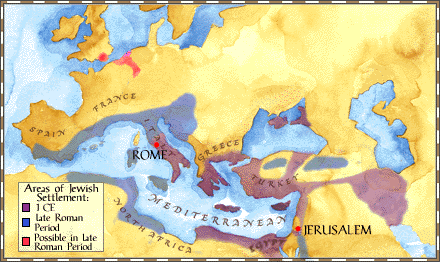As emotion and controversy surround the current crisis in Israel-Palestine, it is easy to forget that a long and complex history is behind the story. We must know this history to gauge a better understanding of the situation, regardless of “side.” The events discussed in this article are perhaps the most important in the past two millennia of Jewish history, setting in motion all future ups and downs of the Jewish people, inciting millennia of inspirational resilience, cultural influence, and tragedies.
At the beginning of the first century C.E., the territory of modern Israel and Palestine was subject to the rule of the newly founded Roman Empire. Before this, it had been under the reign of Greek Empires that had succeeded Alexander the Great for centuries after he conquered it from the Persian Empire. The land was officially known as Roman Judaea and is famous for being the time and place in which Jesus of Nazareth lived and preached. The population of Judaea since the time of the Persians had maintained a stable and positive relationship with their imperial overseers. Cyrus the Great and the other Emperors of the Persian Achaemenid Dynasty allowed for Jewish self-governance and freedom of religion. Then, when the rule of Israel was usurped by Alexander and his generals, the Greek overseers, and native Judeo-Canaanites experienced good relations; the city of Alexandria in Egypt became an intellectual hub for the Jewish people, and the Hebrew Bible (The Old Testament) was translated into Greek in the form of the Septuagint Bible, which still serves as a foundation for many Bible translations today. Greek philosophy and culture took the land by storm, and many, especially wealthier and upper-class Jews such as the philosopher Philo of Alexandria, experienced a Greek education.
However, it was during the Greek reign of the region that tensions between the Gentile (non-Jewish) colonizers and native populations began to grow. The Greek Emperors began to impose their polytheistic religion on the monotheistic population of the land, such as building statues dedicated to Zeus on holy sites. In 167 B.C.E, the Maccabees revolted against their Greek overlords and established a “Greekified” (Hellenized) Jewish Kingdom, under the Hasmonean Dynasty. This is the cause for the celebration of Hanukkah. The kingdom lasted for a century until succession disputes caused political chaos in the kingdom. The Romans, who had been growing in influence across the Mediterranean, and whose Empire was right on the horizon, were called in by Jewish Kings to mediate the crises. Soon enough, the Romans installed a puppet dynasty, the Herodians, though because of inefficient rule, direct Roman governorship was established. This brings us to the time of Jesus in the first century.
The problems that preceded the region’s Roman rule continued under their regime. Rome, especially with the foundation of the new Imperial Cult (proclaiming the deceased Julius Caesar as a god), continued to enforce their religion on the Jewish people. Statues of the Emperor were once again erected on holy sites, which Jesus campaigned against. The first century C.E. was an incredibly active time in the landscape of Jewish religious thought, with of course the Christian movement arising from Jewish apocalypticism, the mystic and mysterious Essenes, and the Pharisees, who would form the basis for what would emerge as modern Rabbinical Judaism. With this fascinating assortment of thoughts, the Jewish people were incredibly divided religiously. However, one thing could be agreed upon. The Romans had to go.
From 66 C.E. onward, riots broke out across Judaea. The Pharisees established a provisional government, and future Roman Emperor Vespasian was ordered to crush the revolt. By 70 C.E., the revolution was pushed into the capital Jerusalem. The Holy City was put under siege by the Roman armies. Incredible chaos persisted, and a four-month-long siege ensued, beginning during Passover. Eventually, Vespasian was recalled to Rome to be crowned Emperor, because of which his son, Titus Flavius, took over the siege. In August, the Roman forces overran the walls of Jerusalem, and a fire spread throughout the city. Roman sources claim the rivaling Jewish factions started the fire, but Jewish sources say it was the Romans. Either way, the Romans sacked the city, and violently destroyed the Holy Temple of Jerusalem. The Revolt was crushed, and as punishment, those involved in the rebellion, and most Jews in Jerusalem and the surrounding area were sold into slavery across the Mediterranean or driven into Exile.
However, a sizable number of Jewish communities continued to thrive in Judaea after the revolt, as it was primarily the Jerusalem population (which was nevertheless huge) that was exiled. Seth Schwartz, a professor of Jewish History and Classical Studies at Columbia University, estimates that approximately half of the population of Judaea at the time was Jewish. However, another Jewish revolt began just 40 years later in 110 C.E., known as the Bar Kokhba Revolt, led by the Jewish leader Simon Bar Kokhba. The retaliation against this revolt was even more severe than the First Jewish War, with Jerusalem being completely depopulated of Jews and central Judaea experiencing a severe population decrease. The cruel Roman Emperor Hadrian, equally famous for his persecution of Christians at the time, ensured the suppression of any Jewish nationalism and resistance to Romanization. The Province was renamed Syria Palaestina after the historical Iron Age Philistine regimes of the region. Many historians consider the actions under Hadrian to be a genocide and inhumane event. However, many natives of Judaea, both Jew and Gentile, especially in rural agricultural regions, remained. Families that had been in the region for millennia, despite suppressing their culture, as seen by the building of a temple for the Roman goddess Venus at the site of the former Temple and the moving of the capital from Jerusalem to the coastal Caesarea Maritima, persisted.
For 200 years, the state of Palestine remained stagnant until the land became once again relevant across the Empire when Emperor Constantine converted to Christianity in 312 C.E. Constantine and his mother recommissioned the pagan temples in Jerusalem to churches and began to allow for safe pilgrimage for the newly legal Christians throughout the Empire. Before Constantine’s era, many of the native populace had even converted to the growing Christianity, which only exploded after Constantine’s reign. For the next 300 years, the Eastern Roman Empire transitioned to the Byzantine Era, Palestine, while Jerusalem grew as a hub of Christian communities.
Then, in the 7th Century C.E., the arrival of Islam shot out of the Arabian Peninsula. Under Caliph Muawiya of the Umayyad Dynasty, the Byzantine (Eastern Roman) territory of Syria Palaestina was incorporated into the Islamic Empire. However, the conversion of the population of both Palestine and Syria was a slow burn. Christian, and by now even returned Jewish communities, were strong in the region, with Muawiya himself paying respects at the Holy Christian site of the Holy Sepulchre in Jerusalem. However, with time, the region’s population would widely convert to Islam. There was an influx of Arab nobles in the area, as well as traders. Still, this phenomenon occurred across the Middle East and North Africa, with native populations intermingling with Arab populations, and Arabic becoming a lingua franca. This does not take away the indigenous heritage of the populations across the Middle East and North Africa, with an incredibly diverse and intermixed population throughout.
The people of a land are inseparable from its history. The population undergoes linguistic, cultural, and religious changes along with its regime. It’s important to understand the rich history and lineage of modern Palestinians, as well as the unfortunate and brutal persecution undergone by the Jewish diaspora exiled from the land that began with the crucial Jewish Revolt and destruction of the culturally important Jewish Temple. No matter our beliefs, we must recognize the misfortune and harmful consequences of violent and brutal regimes that led to “all of this” in the first place.







